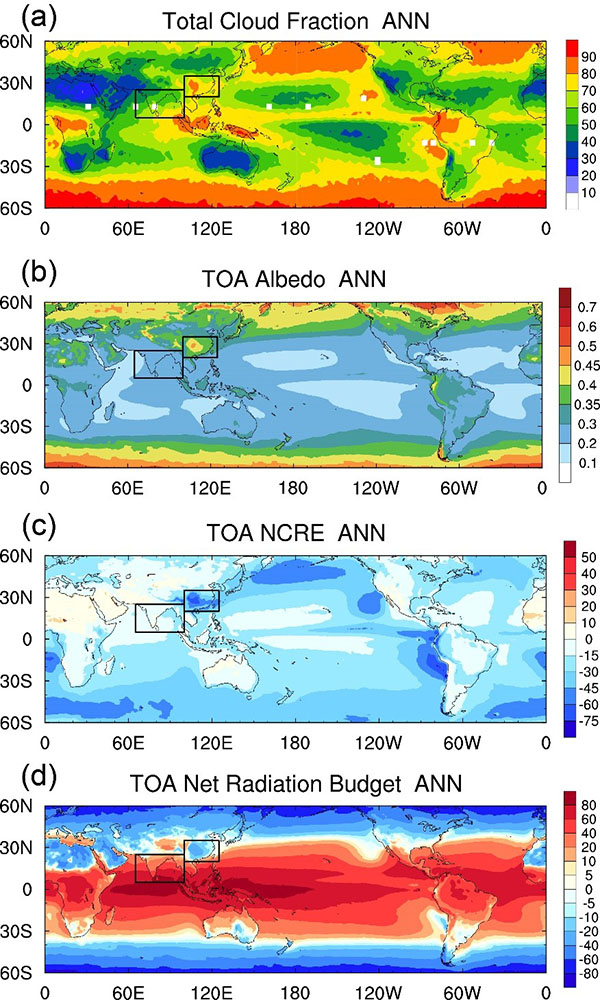State Key Laboratory of Numerical Modeling for Atmospheric Sciences and
Geophysical Fluid Dynamics (LASG)
Institute of Atmospheric Physics, Chinese Academy of Sciences

Vol. 5/No.5 April 2018
[Atmospheric Physical Process]Seasonal features of cloud radiative effects and relevant seasonal variation
Clouds play key roles in energy and hydrological cycle of earth climate system by influencing atmospheric radiative heating, surface energy balance, general circulation and precipitation process. At present, cloud physics process is one of the biggest difficulties in climate simulation and prediction. Meanwhile, clouds exhibit pronounced spatial-temporal features closely related to general circulation. East Asia is such a region, where strong seasonal contrast and distinctive cloud radiative effects (CREs) occur.
To well understand regional cloud roles and their relationships with general circulation and precipitation, a series of studies are conducted to investigate seasonal features of cloud radiative characteristics over East Asia. The authors include researchers from Institute of Atmospheric Physics at Chinese Academy of Sciences, State University of New York at Albany, Department of Hydrology and Atmospheric Sciences at University of Arizona, Chinese National Climate Center and College of Atmospheric Sciences at Lanzhou University.
Their study results indicate that the annual mean cloud albedo and net CRE over Eastern China are the strongest at the same latitude and its CREs is dominated by shortwave CRE (cooling) (As shown in Fig. 1), with the peak in summer. The presence of extensive and opaque low-level clouds contributes to large Top-of-Atmosphere albedo in winter. The relationships between CREs and precipitation are much complicated in Eastern China than in South Asia, indicating distinctive regional variations over East Asian monsoon region. In addition, similar to current state-of-art climate models, most reanalysis underestimate annual and winter mean total cloud fraction, shortwave CRE, and net CRE (NCRE) over East Asia, with the negative biases up to 40%. The results suggest a consistent description of both longwave and shortwave radiative parameterization and reasonable presentation of cloud vertical distribution are needed in current climate models.

Fig. 1 Annual mean a total cloud fraction (%, hereafter TCF) derived from GOCCP (GCM Oriented CALIPSO Cloud Product) during the period 2007–2014, b all-sky albedo, c net CRE (W m−2, hereafter NCRE) and d net radiation budget (W m−2) at the TOA derived from NASA CERES-EBAF during the period 2001–2014. The black boxes represent the Asian Monsoon Regions in this study, including Eastern China (EC, 20–35°N, 100–125°E) and South Asia (SA, 5–25°N, 65–100°E)“High, middle and low level clouds, and large-scale and convective cloud types often coexist over Eastern China. Furthermore, stronger winter-summer transition of general circulation also makes cloud-radiation processes over East Asia more complicated than over South Asia,” said Jiandong Li, first author on these papers and a research scientist in Institute of Atmospheric Physics at Chinese Academy of Sciences. “Currently, satellite retrieved products only reflect parts of cloud information and large diversity also exists in these datasets. In this situation, comparison investigation from general circulation and other climatic processes could provide new perspectives for regional cloud roles”.
"Combination of cloud-radiation physics and climatic analysis is much helpful to understand cloud effects," Li said. "We need more these cross-disciplinary studies, especially for overcoming the great difficulties from clouds complexity in both their form diversities and physical parameterization in current climate models."
Relevant work have been published as follows.
Li, J. D., W.-C. Wang, X. Q. Dong, and J. Y. Mao, 2017: Cloud-radiation-precipitation associations over the Asian monsoon region: an observational analysis. Climate Dynamics, 49(9), 3237–3255.
Li, J. D., J. Y. Mao, and F. Wang, 2017: Comparative study of five current reanalyses in characterizing total cloud fraction and top-of-the-atmosphere cloud radiative effects over the Asian monsoon region. International Journal of Climatology, 37: 5047–5067.
Li, J. D., T. H. Wang, and A. Habib, 2017: Observational characteristics of cloud radiative effects over three arid regions in the Northern Hemisphere. Journal of Meteorological Research, 31(4), 654–664.
Li, J. D., and J. Y. Mao, 2015: The preliminary evaluation of global and East Asian cloud radiative effects in reanalyses. Atmospheric and Oceanic Science Letters, 8 (2): 100–106.
Li, J. D., Y. M. Liu, and G. X. Wu, 2009: Cloud Radiative Forcing in Asian Monsoon Region Simulated by IPCC AR4 AMIP Models. Advance in Atmospheric Sciences, 26(5): 923–939.
Contact: LI Jiandong, lijd@mail.iap.ac.cn
E-mail: lasg_newsletter@lasg.iap.ac.cn
Editors: Chuanyi Wang (wangcy@lasg.iap.ac.cn), Kangjun Chen(ckj@lasg.iap.ac.cn)